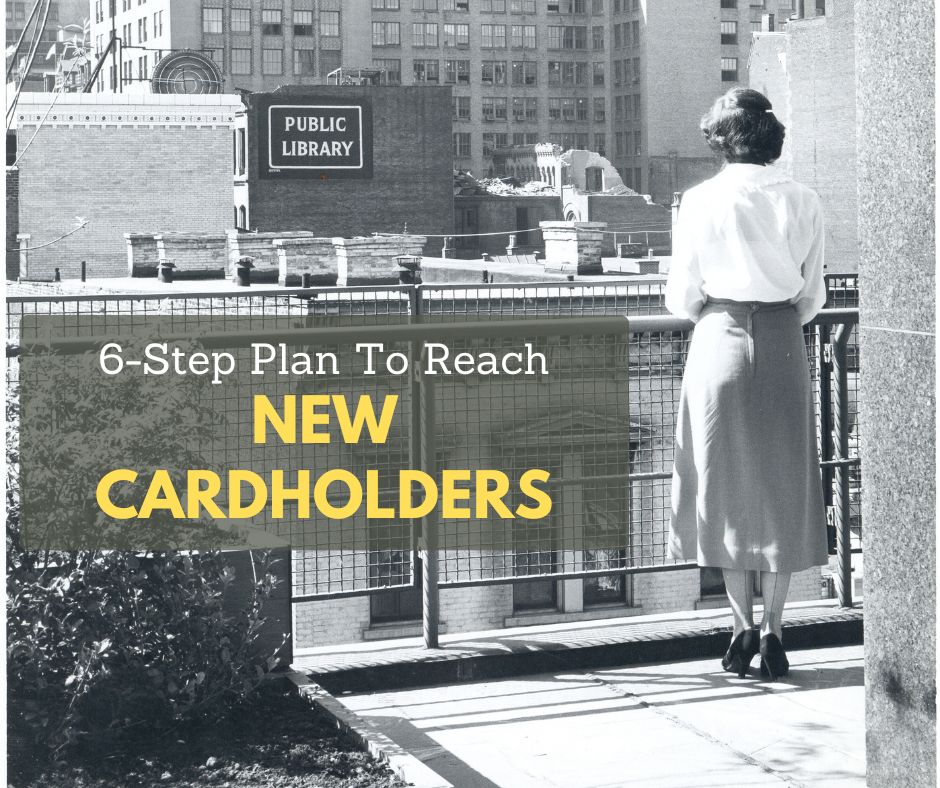
There is nothing like the thrill of someone discovering your library for the first time.
New users are often dazzled by the notion that they can check out items from your collection and use your services, without having to pay anything (except taxes, in most cases). That joy is contagious, and it’s a big thrill for library staff.
Many of you are actively searching for ways to reach people in your community who may not have used the library before. In the most recent Super Library Marketing survey, you told me that you struggle to promote to non-cardholding community members. Several of you named specific target audiences you hope to reach, including young adults, parents and caregivers of young children, and non-English speaking communities.
Let’s first lay out an effective approach your library can take to craft a message that resonates with new cardholders. Then, we’ll talk about tactics you can use to reach them.
The Problem-Solution approach
The Problem-Solution approach is a subtle and effective shift in the way we think about promotions.
These messages show that you understand your audience’s problems and that your library offers solutions to those problems. It’s marketing with empathy. It’s best explained with an example.
An example of the Problem-Solution approach
I recently saw a real-life library’s strategic plan which included a pledge to increase access to the collection for underserved communities, immigrants, and new residents. They also want to provide support to new residents trying to learn English as a second language. This library has a robust collection of reading materials in a variety of languages and ESOL programs.
Now, normally your collection promotion might sound something like this:
“Get a library card and get access to thousands of books to read for pleasure, for work, or for study, all for free. And learn a new language by attending our programs.”
But using the problem-solution approach, with immigrants and new residents as the target audience, the message would sound like this:
“Are you struggling to find books, movies, and music in your native language? Are you hoping to learn a new language in your new home? Your library is there for you. We have an extensive collection of books in lots of languages. You can also learn and practice English in a safe and supportive environment. All you need is a free library card.”
In this example, your next step would of course be to translate that message into the language of your target audience. Then, you’ll proceed with the 6-step plan to reach this new audience.
6-step plan to reach new audiences
Step 1: Make it easy to find your card signup application.
In my day job at NoveList, I look at library websites and evaluate their customer experience and promotions. Unfortunately, I often have to hunt pretty aggressively for information about applying for a library card. Sometimes, I can’t find it at all!
The most important thing to do to get more new cardholders is to make signing up easy! Your cardholder application should be front and center on your website. A frequently asked questions section for new cardholders is also a good idea.
Step 2: Target new audiences with a little money on social media.
You don’t have to spend much money to reach your target audience. Most libraries can spend about two to three dollars a day to boost a post or an ad to see results.
It’s easy to set up your ads for maximum effectiveness. You can choose the audience based on a huge list of demographics, including geographic location, age, and interests. Facebook will help you craft the call to action, image, and headline that will work best for your ad.
You can link your Instagram page to your Facebook page to buy identical ads for both platforms. I recommend this strategy, as you’re more likely to reach non-cardholders by combining efforts on both platforms.
Step 3: Incentivize current cardholders to recruit new cardholders.
Ask current cardholders to recruit a new cardholder for a chance to win a prize. The prize could be library swag or gift cards from local businesses.
To promote your contest, email your cardholders to let them know about the giveaway. Create small flyers or bookmarks to promote your contest and slip them into holds, curbside pickup bags, or make-and-take craft bags.
Step 4: Incentivize staff to recruit new cardholders.
Get some extra gift cards and give them away to staff members. Or give away a half day of vacation, an extra-long lunch, a free parking space, or the privilege of wearing jeans to work for a day.
You can do a straight giveaway, where every staff member who manages to recruit a new cardholder is entered to win a prize. Or you can make it competitive, rewarding the staff member with the most signups.
Step 5: Pitch real stories of library cardholders to the media.
Instead of sending out a generic press release about the benefits of a library card, send your media contacts a pre-written story of a real person who got help with a real problem at the library.
Write your cardholder story with emotion, some conflict, and a resolution. Add some pictures or videos, and then hit send.
Reporters and newsrooms are more likely to pick up a story about a real person than a press release. And the coverage will get your library exposure in front of an entirely new audience.
Step 6: Ask your partners for help.
Ask partner organizations to distribute a bookmark or some other kind of small print promotional piece to their visitors.
Local realtors and rental agencies could give your promotional piece to prospective homeowners or new renters. Send some of your library card sign-up print pieces to daycare providers, teachers, summer camps, and recreational centers. You can even ask restaurants to include a library card signup flyer or bookmark in their takeout bags!
P.S. You might also find this helpful
Subscribe to this blog and you’ll receive an email whenever I post. To do that, enter your email address and click on the “Follow” button in the lower left-hand corner of the page. You can also follow me on the following social media platforms:







